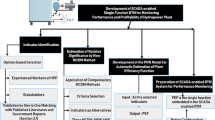Abstract
This study designed an ambient intelligence (AmI)-based decision support system that combined an electromagnetism-like mechanism (EM) and sensory data to aid human operators in making decisions regarding the management of cascade hydropower systems. Currently, cascade hydropower systems are the primary source of hydropower in Taiwan, and the Dajia Hydropower System is the largest one in Taiwan. The operational considerations of the various plants in this system include water levels constraints, minimal water release constraints, and maximal water release constraints. These considerations must be emphasized to plan the hourly water release rate and to maximize the power generation profitability of the overall system. Although extant operations are viable, an accurate calculation method for maximizing the economic efficiency of hydropower generation is yet to be developed. The AmI-based system proposed in this study can be used to determine the periodic water release at each plant in the system, thereby maximizing the company’s power-generation profit. In addition, the proposed system was compared with the scheduling system currently employed by the Dajia Hydropower System. The scheduling operations of the Dajia Hydropower System for 23 nonsummer days and a whole year were examined, respectively, and the hydropower plant’s original scheduling method was compared with that of the proposed system. Test results indicated that the scheduling plan obtained from the proposed system increased the profit of the Taiwan Power Company.




Similar content being viewed by others
References
Aarts E, Wichert R (2009) Ambient intelligence. In: Technology guide. Springer, Berlin, Heidelberg, pp 244–249
Ali MM, Golalikhani M (2010) An electromagnetism-like method for nonlinearly constrained global optimization. Comput Math Appl 60:2279–2285
Banos R, Manzano-Agugliaro F, Montoya FG, Gil C, Alcayde A, Gómez J (2011) Optimization methods applied to renewable and sustainable energy: A review. Renew Sustain Energy Rev 15:1753–1766
Basu M (2014) Improved differential evolution for short-term hydrothermal scheduling. Electr Power Energy Syst 58:91–100
Birbil SI, Fang SC (2003) An electromagnetism-like mechanism for global optimization. J Global Optim 25:263–282
Birbil SI, Fang SC, Sheu RL (2005) On the convergence of a population-based global optimization algorithm. J Global Optim 30:301–318
Bogdanowicz M, Scapolo F, Leijten J, Burgelman, JC (2001) Scenarios for ambient intelligence in 2010. Office for Official Publications of the European Communities, Luxembourg, pp 3–8
Cook DJ, Augusto JC, Jakkula VR (2009) Ambient intelligence: technologies, applications, and opportunities. Pervasive Mob Comput 5:277–298
Filip FG (2008) Decision support and control for large-scale complex systems. Annu Rev Control 32:61–70
Heilala J, Klobut K, Salonen T, Siltanen P, Ruusu R, Armijo A, Jung A (2011) Ambient Intelligence based monitoring and energy efficiency optimisation system. In: 2011 IEEE International Symposium on Assembly and Manufacturing
Li A, Wang L, Li J, Ji C (2009) Application of immune algorithm-based particle swarm optimization for optimized load distribution among cascade hydropower stations. Comput Math Appl 57:1785–1791
Liao X, Zhou J, Zhang R, Zhang Y (2012) An adaptive artificial bee colony algorithm for long-term economic dispatch. Electr Power Energy Syst 43:1340–1345
Mantawy AH, Soliman SA, El-Hawary ME (2003) The long-term hydro-scheduling problem-a new algorithm. Electr Power Syst Res 64:67–72
Stokic D, Kirchhoff U, Sundmaeker H (2006) Ambient intelligence in manufacturing industry: Control system point of view. In: The Eighth IASTED International Conference on Control and Applications
Author information
Authors and Affiliations
Corresponding author
Rights and permissions
About this article
Cite this article
Tseng, CT., Lee, YL. & Chou, CC. An ambient intelligence system for water release scheduling in cascade hydropower systems. J Ambient Intell Human Comput 6, 47–55 (2015). https://doi.org/10.1007/s12652-014-0250-y
Received:
Accepted:
Published:
Issue Date:
DOI: https://doi.org/10.1007/s12652-014-0250-y




